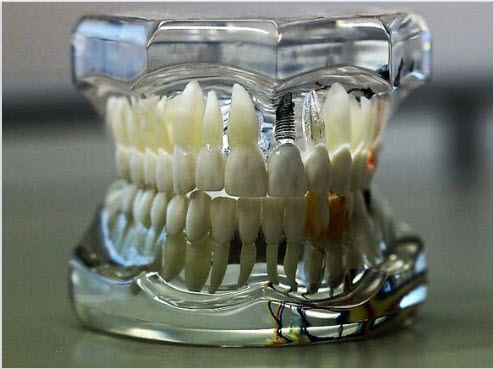Choosing between dentures and implants.

Most people are a little unsure about dental prosthetic devices until they actually need to consider one. Devices such as dentures are obvious enough, but bridges and implants are sometimes less familiar. Each of these options is suitable for different people with different dental needs. And by knowing some basic facts, when choosing between dentures and implants, you too can make an informed choice.
The pros and cons of dentures
Many Australians would be aware of dentures. They’re a cost effective option, and often quite popular with older patients. Dentures don’t require surgery, but as a tradeoff you do need to have a new denture made if your jaw or mouth changes.
In terms of long-term maintenance, dentures have a little clasp that attaches to your neighbouring teeth and this area always needs to be checked ensuring that no damage is caused.
In terms of the client’s everyday experience, dentures are less comfortable over the long term and sometimes when they move around they can be a little embarrassing in social situations.
Pros and cons of bridges
Bridges are a little more complex. You need to recontour the neighbouring teeth by removing part of the natural tooth substance, and attach a crown-like structure there. Then the covered section in between forms the bridge.
The slight downside of this technique is that you need to have a lifetime of maintenance, to care for those neighbouring teeth that ‘support’ the bridge. In some cases this may lead to a ‘destruction of tooth’ incident. Here you can see why some patients choose implants instead as you are only dealing with the tooth—or teeth—in question, not the neighbouring teeth.
Pros and cons of implants
Implants are obviously a bit more invasive in that you have an initial surgical procedure—but once you’ve recovered that experience is soon forgotten. Implants are wonderful in that you are only working on the missing space—not the neighbouring teeth.
As far as results, many patients soon forget they have implants at all—they look and function very similarly to their natural teeth. They’re comfortable and soon people just get on with everyday life. In terms of maintenance, patients need to come in for regular hygiene checks and assessment of their implants.
In conclusion
As you can see, dental procedures and devices vary in their design, implementation, look, function, cost and long-term maintenance. Your situation may suit the use of implants – and another person may choose a different solution. But by having a little knowledge to start with, you can speak to your dental health professional and aim for a great result.
